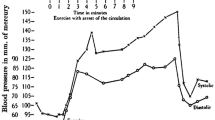Summary
-
1.
Under hypercapnic acidosis an initial decrease of myocardial contractile force is seen, but in some vertebrate species it is followed by a recovery. The resulting force level is higher in air-breathers, like a turtle (Pseudemys scripta), a snake (Vipera berus), and the laboratory rat, than in the waterbreathing fishes, trout and carp. The hearts of the leopard frog and grass frog are intermediate although the former tolerate hypercapnic acidosis better than the latter.
-
2.
Cyanide does not affect the hypercapnic force development of the leopard frog, while it induces a recovery process in that of the grass frog. Since cyanide is known to release intracellularly bound Ca2+ this suggests that the recovery involves a changed Ca2+ distribution.
-
3.
Incubation of cardiac strips fromVipera berus and trout in a Na+- and Ca2+-free Ringer causes an increase in resting tension. Under hypercapnic acidosis a decrease of this tension occurs which, however, for the strips from the viper is followed by recovery. The recovery process thus seems to be independent of extracellular Ca2+ or Na+. It also seems independent of the Ca2+ contained in the sarcoplasmatic reticulum, since the recovery of resting tension in the viper strips is unaffected by pretreatment with caffeine.
-
4.
In viper myocardial strips, which develop high force under anoxia, the force loss by acidosis is increased and spontaneous recovery substantially depressed when hypercapnia is imposed after a 60 min pretreatment with agents unloading mitochondrial Ca2+-stores (anoxia and anoxia + oligomycin).
-
5.
These findings favour the hypothesis that hypercapnic acidosis triggers the release of Ca2+ from intracellular stores, probably from mitochondria.
Similar content being viewed by others
References
Aickin, C.C., Thomas, R.C.: An investigation of the ionic mechanism of intracellular pH regulation in mouse soleus muscle fibres. J. Physiol.273, 295–316 (1977)
Boron, W.F., De Weer, P.: Intracellular pH transients in squid giant axons caused by CO2, NH3 and metabolic inhibitors, J. Gen. Physiol.67, 91–112 (1976)
Brierly, G.P., Murer, E., Bachman, E.: Studies on ion transport. III. Accumulation of Ca2+ and phosphate by heart mitochondria. Arch. Biochem. Biophys.105, 89–103 (1964)
Carafoli, E., Tiozzo, R., Lugli, G., Crouetti, F., Kratzing, C.: The release of calcium from heart mitochondria by sodium. J. Mol. Cell. Cardiol.6, 361–371 (1974)
Drahota, Z., Carafoli, E., Rossi, C.S., Gamble, R.L., Lehninger, A.L.: The steady state maintenance of accumulated Ca2+ in rat liver mitochondria. J. Biol. Chem.240, 2712–2720 (1965)
Ellis, D., Thomas, R.C.: Direct measurement of the intracellular pH of mammalian cardiac muscle. J. Physiol.262, 755–771 (1976)
Fabiato, A., Fabiato, F.: Activation of skinned cardiac cells. Subcellular effects of cardioactive drugs. Eur. J. Cardiol.1, 143–155 (1973)
Foëx, P., Fordham, R.M.M.: Intrinsic myocardial recovery from the negative inotropic effects of acute hypercapnia. Cardiovasc. Res.6, 257–262 (1972)
Jundt, H., Porzig, H., Reuter, H., Stucki, J.W.: The effects of substances releasing intracellular calcium ions on sodium-dependent calcium efflux from Guinea-pig auricles. J. Physiol.246, 229–253 (1975)
Nakamura, Y., Schwartz, A.: Possible control of intracellular calcium metabolism by (H+): Sarcoplasmatic reticulum of skeletal and cardiac muscle. Biochem. Biophys. Res. Comm.41, 830–836 (1970)
Poupa, O.: Some trends of the natural defense against the cardiac anoxia. Acta Med. Scand. (Suppl.)587, 47–56 (1975)
Poupa, O., Gesser, H., Johansen, K.: Differences in negative inotropic effect of CO2 on the myocardium in the water- and air-breathing vertebrates (Salmo gairdneri andPseudemys scripta elegans). Am. J. Physiol.234, 155–157 (1978)
Poupa, O., Johansen, K.: Adaptive tolerance of fish myocardium to hypercapnic acidosis. Am. J. Physiol.228, 684–688 (1975)
Santer, M., Cobb, J.L.S.: The fine structure of the heart of the Teleost,Pleuronectes platessa L. Z. Zellforsch.131, 1–14 (1972)
Schaffer, S., Safer, B., Williamson, J.R.: Investigation of the role of mitochondria in the cardiac contraction-relaxation cycle. FEBS Lett.23, 125–130 (1972)
Serur, J.R., Skeleton, C.L., Bodem, R., Sonnenblick, E.H.: Respiratory acid-base changes and myocardial contractility: Interaction between calcium and hydrogen ions. J. Mol. Cell. Cardiol.8, 823–36 (1976)
Weber, A., Herz, R.: The relationship between coffeine contracture of intact muscle and the effect of coffeine on reticulum. J. Gen. Physiol.52, 750–759 (1968)
Williamson, J.R., Safer, B., Rich, T., Schaffer, S., Kobayashi, K.: Effects of acidosis on myocardial contractility and metabolism. Acta Med. Scand. (Suppl.)587, 95–111 (1975)
Author information
Authors and Affiliations
Rights and permissions
About this article
Cite this article
Gesser, H., Poupa, O. The role of intracellular Ca2+ under hypercapnic acidosis of cardiac muscle: Comparative aspects. J Comp Physiol B 127, 307–313 (1978). https://doi.org/10.1007/BF00738414
Accepted:
Issue Date:
DOI: https://doi.org/10.1007/BF00738414




